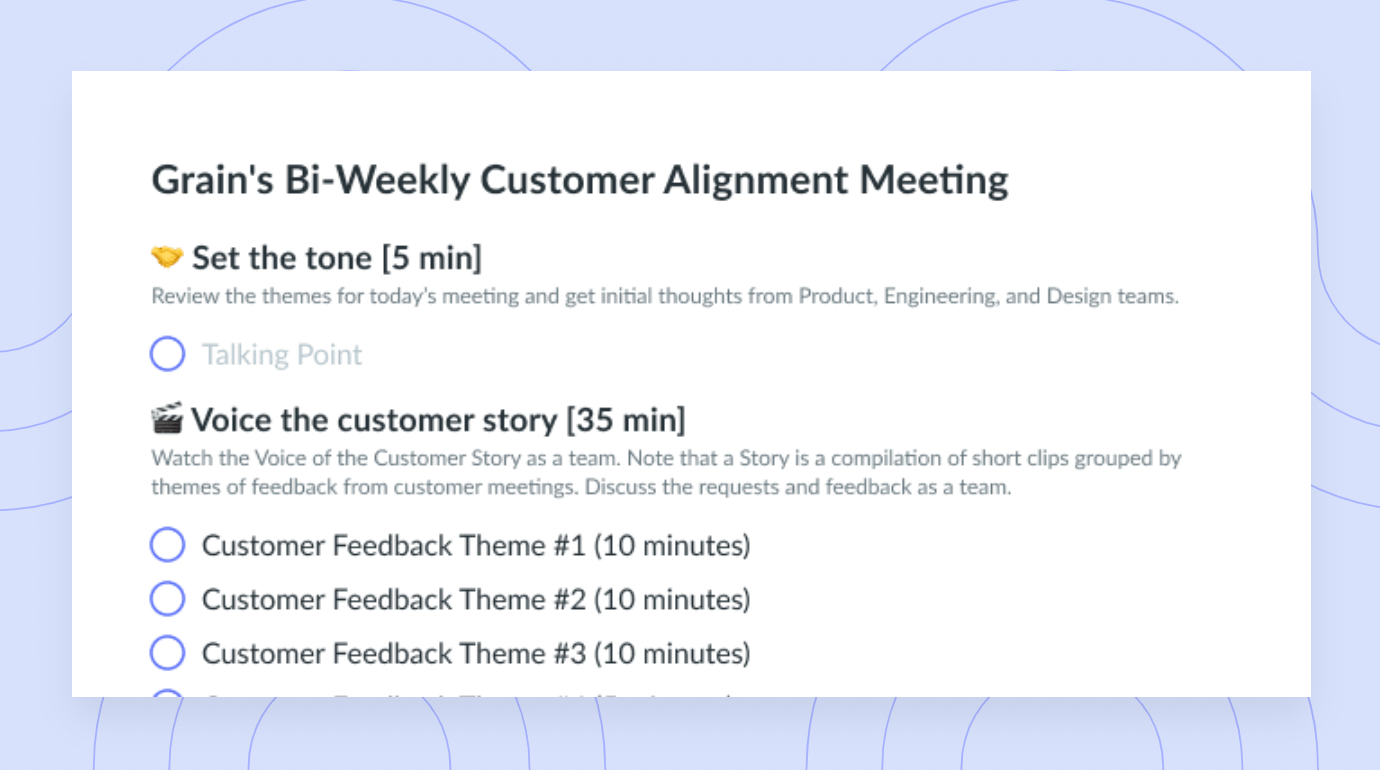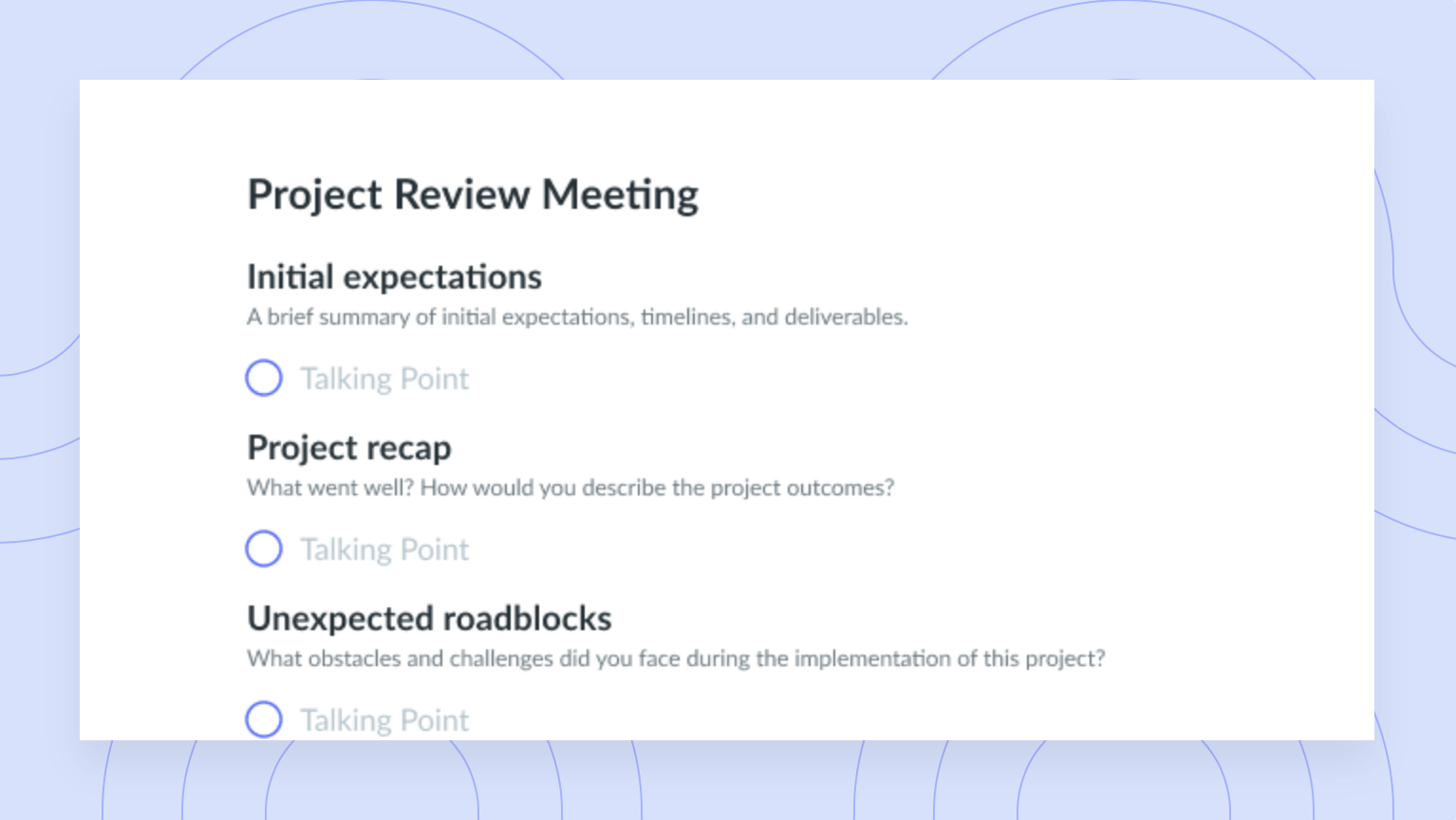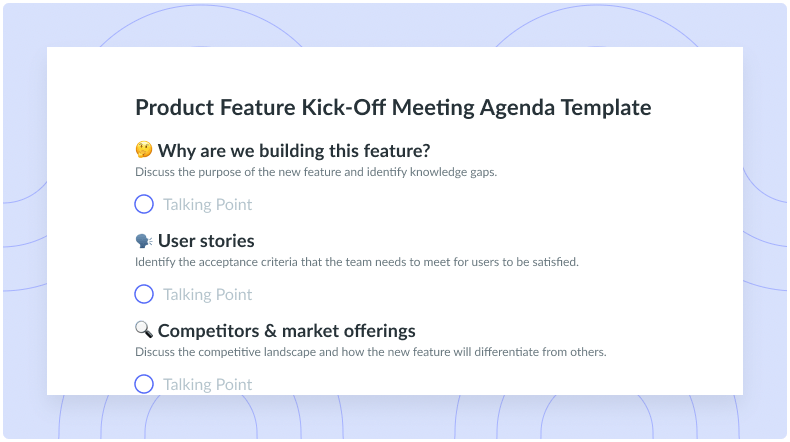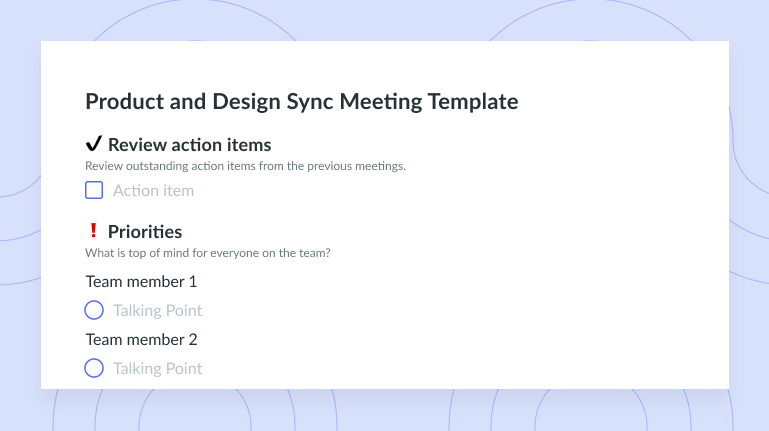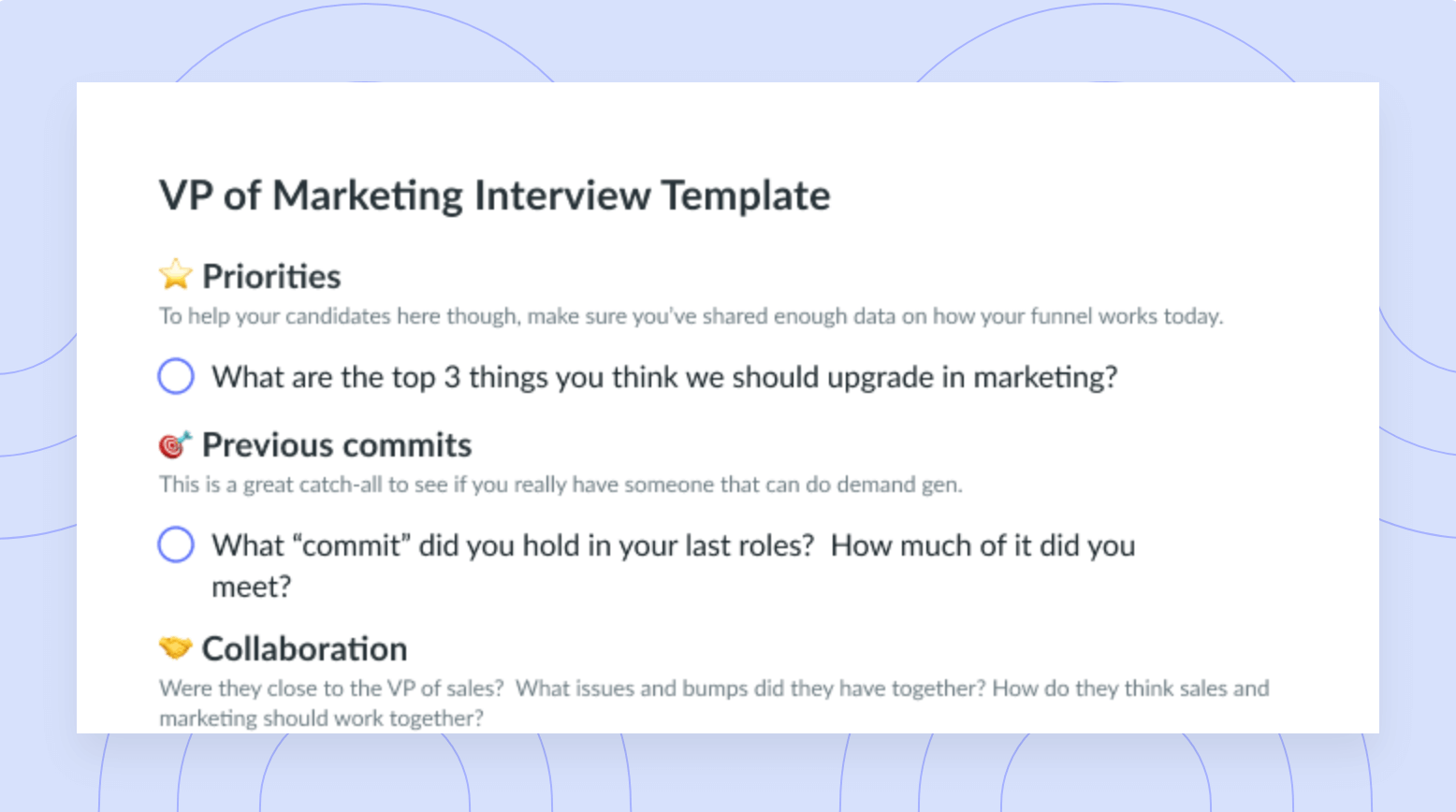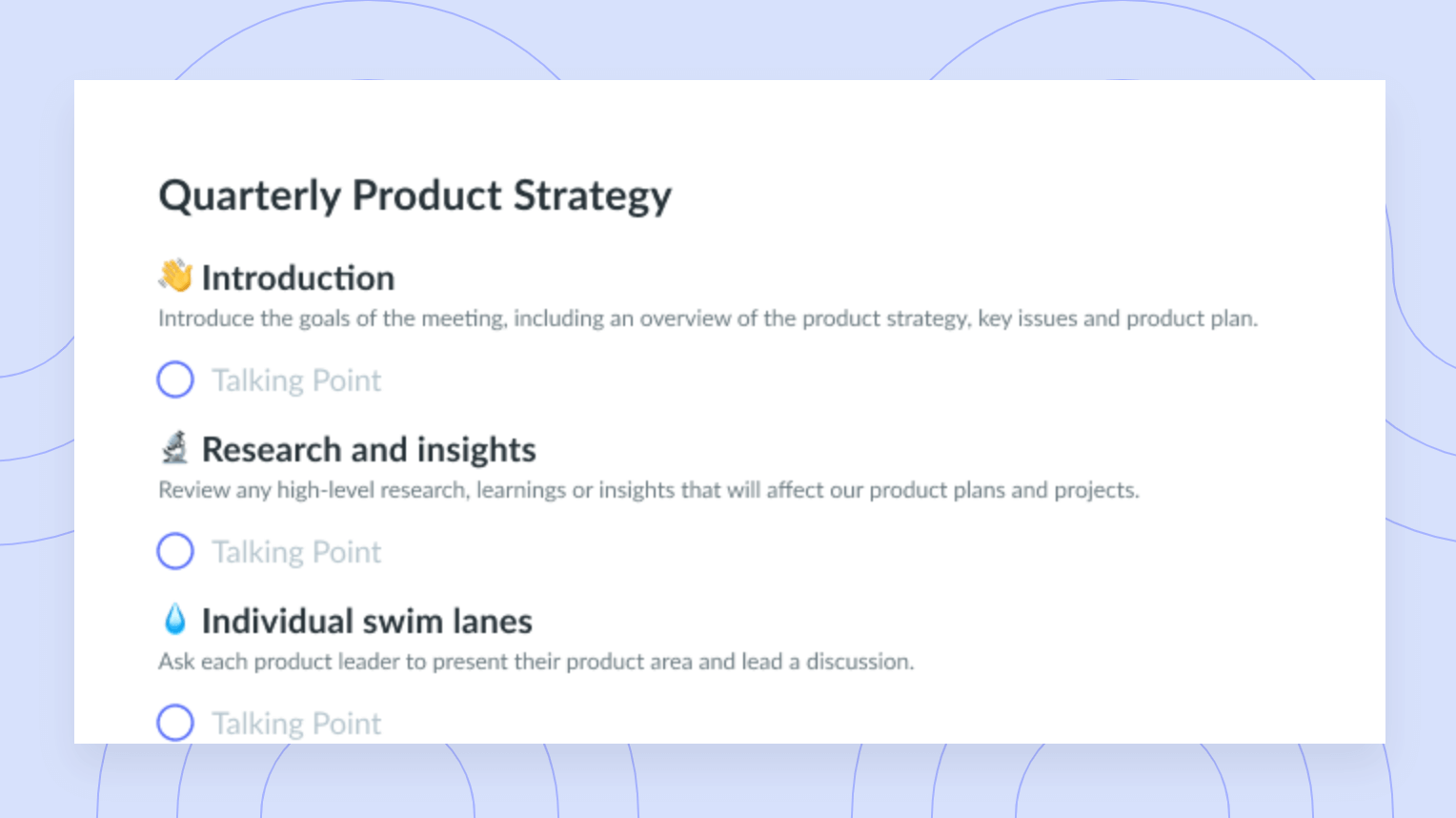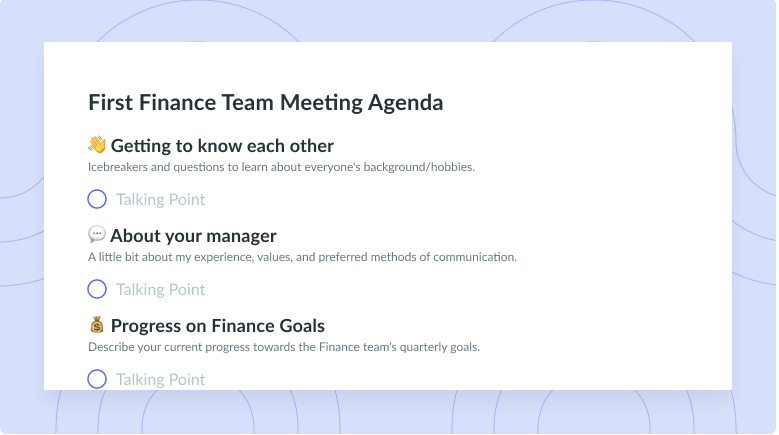Product Meeting Ideas: 5 Tactics to Run Remarkable Meetings
When great minds come together, great things can happen. Here are five meeting tactics verified by the best product teams.
Meetings. A necessary evil. But do they have to be evil?
When meetings are done well, they can keep your team informed, keep the lines of communication running freely between colleagues, and even be a source of inspiration for your upcoming projects.
If you want your meetings to be valuable for your team, maybe it’s time to re-think how you’ve been running them. Meetings are a key leadership skill that often gets left to the wayside.
Let’s take a look at the tactics used by top companies to run really kickass meetings.
- Define the purpose of the meeting
- Figure out who really needs to be there
- Give the meeting a structure
- Let your Product team get creative
- Make sure your talking points have action points
1 Define the purpose of the meeting
This should be a no-brainer, but it’s amazing how many meetings are held just for the sake of it. It’s important for teams to stay connected and you need to make sure everyone is on the same page, and it’s important to do that with focus.
Think about the type of meeting you need:
- Retrospective Meeting: coming together to reflect on what went well (or didn’t) with your last launch/product/quarter and discuss key takeaways. This type of meeting is particularly popular with Product Managers and Agile teams.
- Weekly Roundup: giving everyone a general update on how things are going and finding out what people are working on.
- Quarterly Product Strategy Meeting: similar to the weekly roundup, but focused on a particular product, providing key context and learnings for the whole Product team.
- One-on-One Meeting: catching up with an individual teammate, giving you a closer look at what they’re working on and allowing them to have a few moments of your undivided attention.
- Project Planning: bringing the whole team together to lay out a blueprint for your Next Big Thing.
- Crisis Management: hopefully you’ll never have to run one of these!
Knowing precisely what kind of meeting they’re going into will help your team prepare and know what to expect. If you have a set procedure within your company for particular types of meetings, you won’t constantly find yourself answering questions like ‘where are we meeting?’, ‘what should I bring?’, ‘what’s going on?’, ‘do I need to be there?’, etcetera.
2 Figure out who really needs to be there, and make sure everyone gets involved
Google Chair, Eric Schmidt, enforces the rule that a meeting should have no more than 8 people, to keep things concise and stop conversations drifting off-topic or getting out of hand.
Nobody likes to have their time wasted.
Your colleagues will certainly appreciate not having to sit in a meeting room where they’re not really needed. Yes, sometimes there are company-wide updates that they need to be aware of, but unless they need to be discussed in-depth, these are the sorts of things that can be summed up in an email.
Once you have the right people in the room, make sure everyone gets involved. This doesn’t have to be in a school-teacher-style of pointing someone out and asking them to stand at the front of the class.
According to Tesla and SpaceX employees, if you don’t contribute to a meeting Elon Musk is in, he’ll call you out!
Maybe you don’t need to go quite that far, but it’s worth making sure everyone in the room pitches in.
3 Give the meeting a structure
The best way to avoid the long rambling meetings that last way too long and go off-topic, is to come up with an agenda and timeframe. If your teammates are busy people (as most of us are) they’ll appreciate knowing exactly what’s going to be talked about and how long it’s going to take.
- Create an event in people’s work calendars so they know when and where the meeting is taking place. Include a brief description of what talking points you’ll be going over to allow them time to prepare. A well-prepped team will always lead to better, more efficient meetings.
- You should also allow your team to collaborate on the structure of the meeting. Share the agenda with them in advance and ask if there’s anything they feel should be added to it. Not only will your teammates appreciate feeling heard, but it’ll make sure you don’t miss anything important.
4 Let your Product team get creative
There’s a time for structure, and there’s a time to let ideas flow! When great minds come together, great things can happen. Sometimes your colleagues have great ideas bubbling away under the surface, but lack the forum to express them.
Let’s say you’re redesigning your website. You want to give it a fresh new look and do something really innovative. You’re willing to put some serious budget behind it and you want to make sure it’s well spent. Some managers may keep this just between them and the product team, but don’t be afraid of opening up the project to everyone else.
- Create an optional meeting (perhaps providing snacks as motivation) and invite your team members to join you.
- Give everyone 5 sticky notes and tell them they have 2-3 minutes to write down 5 different website features/design elements which they think could be fun/more useful. It’s important that people feel comfortable enough not to hold back. Ideas should be realistic, but anything within the realm of possibility is ok!
- Stick the notes up on the wall or a whiteboard and read through the ideas together. (You can remove any that aren’t possible at all, like smell-o-vision.) Give yourselves 5 minutes to talk through the ideas.
- Then give everyone a pen, and ask everyone to draw ticks, stars, smiley faces, or whatever they like on their 3 favorite ideas. They have one minute to do this.
Once this is over, you’ll have at least a handful of fun, innovative ideas for your new website, as voted for by colleagues. This works not only as an exercise, but as team bonding. Your teammates will feel valued, and maybe even inspired too!
5 Make sure your talking points have action points
There’s no point sitting in a room for two hours coming up with a plan if everyone leaves with no idea what their next steps are. If you talked about making improvements on a new feature, anyone involved with that should know what things they have to implement and within what timeframe.
Putting together a collaborative document where anyone can comment or update the status of their tasks will help break down silos and give the whole team a better idea of the bigger picture. In Fellow.app you can assign tasks to individual colleagues so everyone knows exactly what they’re doing, and they’re sent automatically via email after the meeting has ended.
Make sure your action points are effective by:
- Making them clear, with any vital information included.
- Giving them a timeframe. This doesn’t need to be a strict deadline, but it’ll make sure everyone is on the same schedule.
- Assigning them to the right person.
- Making them part of the bigger picture. You team will appreciate knowing they’ve been assigned a task. It’s important to be a storyteller not just for your customers, but for your internal teams as well.
And there you have it! 5 tactics verified by the best Product teams of the modern world. What are your go-tos for running great meetings?
This guest post was written by Product School.









